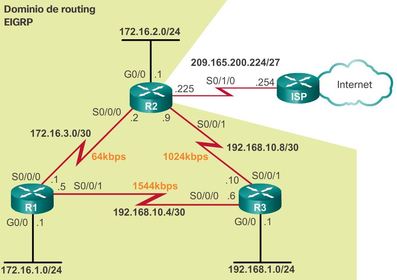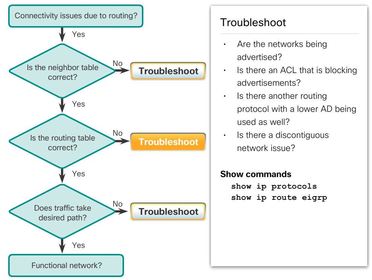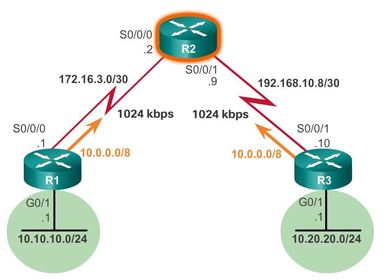CCNA CCNA FlashCards sobre E3_8 EIGRP Troubleshooting, criado por John Dedios em 19-08-2016.
Pin adicionado em
37
0
0
Sem etiquetas
|
|
Criado por John Dedios
mais de 8 anos atrás
|
|
Fechar
|
|
Criado por John Dedios
mais de 8 anos atrás
|
|

EIGRP is a versatile routing protocol that can be fine-tuned in many ways.
** Two of the most important tuning capabilities are the ability to summarize routes and the ability to implement load balancing
EIGRP Automatic summarization
** Summarization decreases the number of entries in routing updates and lowers the number of entries in local routing tables. It also reduces bandwidth utilization for routing updates and results in faster routing table lookups.
To limit the number of routing advertisements and the size of routing tables, routing protocols such as EIGRP, use automatic summarization at classful boundaries. This means that EIGRP recognizes subnets as a single Class A, B, or C network, and creates only one entry in the routing table for the summary route. As a result, all traffic destined for the subnets travels across that one path.
Configuring EIGRP Automatic summarization
Ej: ? command on R1 indicates that EIGRP automatic summarization is disabled.
EIGRP for IPv4 automatic summarization is disabled by default beginning with Cisco IOS Release 15.0(1)M and 12.2(33). Prior to this, automatic summarization was enabled by default.
* This meant that EIGRP performed automatic summarization each time the EIGRP topology crossed a border between two different major class networks.

Configuring EIGRP Automatic summarization
Ej: ? To enable automatic summarization for EIGRP, use the xxxxx command in router configuration mode.
R1(config)# router eigrp (as-number)

Configuring EIGRP Automatic summarization
Ej: Notice that the 172.16.0.0/16 summarized update is not sent out R1’s GigabitEthernet 0/0 and Serial 0/0/0 interfaces.
This is because these two interfaces are members of the same 172.16.0.0/16 class B network. The 172.16.1.0/24 non-summarized routing update is sent by R1 to R2. Summarized updates are only sent out interfaces on different major classful networks.
Verifying Auto-Summary: Topology Table
Ej: The all-links option shows all received updates, whether the route qualifies as a feasible successor (FS) or not. In this instance, R2 does qualify as an FS. R2 is considered an FS because its reported distance (RD) of 2,816 is less than the feasible distance (FD) of 2,170,112 via R1.
Verifying Auto-Summary: Routing Table
Note: Automatic summarization is only an option with EIGRP for IPv4. Classful addressing does not exist in IPv6; therefore, there is no need for automatic summarization with EIGRP for IPv6
Verifying Auto-Summary: Routing Table
The Null0 interface is a virtual IOS interface that is a route to nowhere, commonly known as "the bit bucket." Packets that match a route with a Null0 exit interface are discarded.
EIGRP for IPv4 automatically includes a Null0 summary route whenever the following conditions exist:
* There is at least one subnet that was learned via EIGRP.
* There are two or more network EIGRP router configuration mode commands.
* Automatic summarization is enabled.
Summary Route
Ej: scenario where a routing loop could occur:
9. The packet for 172.16.4.10 is looped between R1 and R2 until the TTL expires and the packet is dropped.
Summary Route (Cont.)
Ej: A summary route on R2 for 172.16.0.0/16 to the Null0 interface, discards any packets that begin with 172.16.x.x, but do not have a longer match with any of the subnets: 172.16.1.0/24, 172.16.2.0/24, or 172.16.3.0/24.
** Even if R2 has a default route of 0.0.0.0/0 in its routing table, the Null0 route is a longer match.
Note: The Null0 summary route is removed when autosummary is disabled using the no auto-summary router configuration mode command.
Configuring EIGRP Manual Summary Routes
To establish EIGRP manual summarization on a specific EIGRP interface, use the following interface configuration mode command:
Router(config-if)# ip summary-address eigrp (as-number) (network-address) (subnet-mask)
EIGRP for IPv6: Manual Summary Routes
** While autosummarization is not available for EIGRP IPv6 networks, it is possible to configure manually summarized routes for EIGRP IPv6.
To configure EIGRP for IPv6 manual summarization on a specific EIGRP interface, use the following interface configuration mode command:
Router(config-if)# ipv6 summary-address eigrp (as-number) (prefix/prefix-length)
Propagating a Default Static Route
One method of propagating a static default route within the EIGRP routing domain is by using the "redistribute static" command that tells EIGRP to include static routes in its EIGRP updates to other routers.
Propagating a Default Static Route
Ej: ? verifies that the default route has been received by router R2 and installed in its IPv4 routing table.
Propagating a Default Static Route
Ej: ? command verifies that R2 is redistributing static routes within the EIGRP routing domain
Verifying the Propagated Default Route
" * " - The route is a candidate for a default route.
- EX - The route is an external EIGRP route, in this case a static route outside of the EIGRP routing domain.
Ej: Notice that R1 selects R3 as the successor to the default route because it has a lower feasible distance. Default routes provide a default path to outside the routing domain and, like summary routes, minimize the number of entries in the routing table.
EIGRP for IPv6: Default Route
Ej: ? The IPv6 default static route is redistributed into the EIGRP for IPv6 domain
Recall that EIGRP maintains separate tables for IPv4 and IPv6; therefore, an IPv6 default route must be propagated separately,
* The ::/0 prefix and prefix-length is equivalent to the 0.0.0.0 0.0.0.0 address and subnet mask used in IPv4. Both are all-zero addresses with a /0 prefix-length.
EIGRP for IPv6: Default Route
Ej: ? The propagation of the IPv6 static default route can be verified
Notice that the successor or next-hop address is not R2, but R3. This is because R3 provides a better path to R2, at a lower cost metric than R1.
Note: Some IOSs may require that the redistribute static command include the EIGRP metric parameters before the static route can be redistributed.
EIGRP Bandwidth Utilization
By default, EIGRP uses only up to 50 percent of an interface’s bandwidth for EIGRP information. This prevents the EIGRP process from over-utilizing a link and not allowing enough bandwidth for the routing of normal traffic.
Use the ip "bandwidth-percent eigrp" command to configure the percentage of bandwidth that can be used by EIGRP on an interface.
Router(config-if)# ip bandwidth-percent eigrp (as-number) (percent)
EIGRP Bandwidth Utilization
To configure the percentage of bandwidth that can be used by EIGRP for IPv6 on an interface, use the ipv6 bandwidth-percent eigrp command in interface configuration mode. To restore the default value, use the no form of this command.
Router(config-if)# ipv6 bandwidth-percent eigrp (as-number) (percent)
Hello and Hold Timers
Hello intervals and Hold times are configurable on a per-interface basis and do not have to match with other EIGRP routers to establish or maintain adjacencies
Router(config-if)# ip hello-interval eigrp (as-number) (seconds)
If the Hello interval is changed, ensure that the Hold time value is equal to, or greater than, the Hello interval. Otherwise, neighbor adjacency goes down after the Hold time expires and before the next Hello interva
Router(config-if)# ip hold-time eigrp (as-number) (seconds)
Hello Intervals and Hold Times with EIGRP for IPv6
EIGRP for IPv6 uses the same Hello interval and Hold times as EIGRP for IPv4. The interface configuration mode commands are similar to those for IPv4:
Router(config-if)# ipv6 hello-interval eigrp (as-number) (seconds)
Router(config-if)# ipv6 hold-time eigrp (as-number) (seconds)
The seconds value for both Hello and Hold time intervals can range from 1 to 65,535.
Load Balancing IPv4
Equal-cost load balancing is the ability of a router to distribute outbound traffic using all interfaces that have the same metric from the destination address. Load balancing uses network segments and bandwidth more efficiently.
** When a packet is process-switched, load balancing over equal-cost paths occurs on a per-packet basis. When packets are fast-switched, load balancing over equal-cost paths occurs on a per-destination basis. Cisco Express Forwarding (CEF) can perform both per packet and per-destination load balancing.
Load Balancing IPv4
Ej: ? command can be used to verify the number of equal-cost paths currently configured on the router.
Cisco IOS, by default, allows load balancing using up to four equal-cost paths; however, this can be modified. Using the maximum-paths router configuration mode command, up to 32 equal-cost routes can be kept in the routing table.
Router(config-router)# maximum-paths value
* If the value is set to 1, load balancing is disabled.
Load Balancing IPv4
Ej: The routing table maintains both routes. Figure 3 shows that R3 has two EIGRP equal-cost routes for the 172.16.3.0/30 network. One route is via R1 at 192.168.10.5 and the other route is via R2 at 192.168.10.9.
Looking at the topology, it may seem as if the path via R1 is the better route because there is a 1544 kb/s link between R3 and R1, whereas the link to R2 is only a 1024 kb/s link.
However, EIGRP only uses the slowest bandwidth in its composite metric which is the 64 kb/s link between R1 and R2. Both paths have the same 64 kb/s link as the slowest bandwidth, this results in both paths being equal.
Unequal-Cost Load Balancing
EIGRP for IPv4 and IPv6 can also balance traffic across multiple routes that have different metrics. This type of balancing is called unequal-cost load balancing. Setting a value using the "variance" command in router configuration mode enables EIGRP to install multiple loop-free routes with unequal cost in a local routing table.
A route learned through EIGRP must meet two criteria to be installed in the local routing table:
1. The route must be loop-free, being either a feasible successor or having a reported distance that is less than the total distance.
Routing Protocol Authentication
In general, routing systems can be attacked through the disruption of peer devices or the falsification of routing information.
Disruption of peers is the less critical of the two attacks because routing protocols heal themselves, making the disruption last only slightly longer than the attack itself.
Routing Protocol Authentication
A method to protect routing information on the network is to authenticate routing protocol packets using the Message Digest 5 (MD5) algorithm.
MD5 allows the routers to compare signatures that should all be the same, confirming that it is from a credible source.
Routing Protocol Authentication
Generally, the originator of the routing information produces a signature using the key and routing data it is about to send as inputs to the encryption algorithm. The router receiving the routing data can then repeat the process using the same key and the same routing data it has received. If the signature the receiver computes is the same as the signature, the sender computes the update is authenticated and considered reliable.
Routing protocols such as RIPv2, EIGRP, OSPF, IS-IS, and BGP all support various forms of MD5 authentication.
Configuring EIGRP with MD5 Authentication
Step 1 - c. Specify the key string for the key. The key string is similar to a password. Routers exchanging authentication keys must be configured using the same key string.
Each key has its own key ID, which is stored locally. The combination of the key ID and the interface associated with the message uniquely identifies the authentication algorithm and MD5 authentication key in use. The keychain and the routing update are processed using the MD5 algorithm to produce a unique signature.
Configuring EIGRP for IPv6 Authentication
The algorithms and the configuration to authenticate EIGRP for IPv6 messages are the same as EIGRP for IPv4. The only difference is the interface configuration mode commands use ipv6, instead of ip.
Router(config-if)# ipv6 authentication mode eigrp (as-number) md5
Router(config-if)# ipv6 authentication key-chain eigrp (as-number) (name-of-chain)
After configuring EIGRP, the first step is to test connectivity to the remote network. If the ping fails, confirm the EIGRP neighbor adjacencies. Neighbor adjacency might not be formed for a number of reasons, including the following:
* The interface between the devices is down.
* The two routers have mismatching EIGRP autonomous system numbers (process IDs).
* Proper interfaces are not enabled for the EIGRP process.
* An interface is configured as passive.

Layer 3 Connectivity
Ej: ? a network administrator can verify that the status and protocol of connecting interfaces are up. A ping from one router to another, directly connected router, should confirm IPv4 connectivity between the devices.
A prerequisite for a neighbor adjacency to form between two directly connected routers is Layer 3 connectivity.
EIGRP Parameters
Ej: ? command verifies that R1, R2, and R3 all use the same autonomous system number.
Note: At the top of the output, “IP Routing is NSF aware” refers to Nonstop Forwarding (NSF).
** This capability allows the EIGRP peers of a failing router to retain the routing information that it has advertised, and to continue using this information until the failed router resumes normal operation and is able to exchange routing information.
EIGRP Interfaces
Ej: ? command displays which interfaces are enabled for EIGRP on R1.
The network command that is configured under the EIGRP routing process indicates which router interfaces participates in EIGRP. This command is applied to the classful network address of the interface or to a subnet when the wildcard mask is included.
EIGRP Interfaces
Ej: ? the "Routing for Networks" section of the show xxx command indicates which networks have been configured; any interfaces in those networks participate in EIGRP.
If the network is not present in this section, use show running-config to ensure that the proper network command was configured.
EIGRP Interfaces
Ej: ? command confirms that any interfaces with these addresses, or a subnet of these addresses, are enabled for EIGRP.
The following are the equivalent commands used with EIGRP for IPv6:
Router# show ipv6 protocols
Router# show ipv6 eigrp interfaces
Passive Interface
Ej: ? To verify whether any interface on a router is configured as passive
One reason that route tables may not reflect the correct routes is due to the passive-interface command. With EIGRP running on a network, the passive-interface command stops both outgoing and incoming routing updates. For this reason, routers do not become neighbors.
Missing Network Statement
Ej: ? on the R1 router shows that the network 10.10.10.0/24 is not advertised to EIGRP neighbors.
** Note: Another form of missing route may result from the router filtering inbound or outbound routing updates. ACLs provide filtering for different protocols, and these ACLs may affect the exchange of the routing protocol messages that cause routes to be absent from the routing table. The show ip protocols command shows whether there are any ACLs that are applied to EIGRP.

Automatic summarization
EIGRP for IPv4 can be configured to automatically summarize routes at classful boundaries. If there are discontiguous networks, automatic summarization causes inconsistent routing.
Ej: R2’s routing table shows that it does not receive individual routes for the 10.10.10.0/24 and 10.20.20.0/24 subnets. Both R1 and R3 automatically summarized those subnets to the 10.0.0.0/8 classful boundary when sending EIGRP update packets to R2. The result is that R2 has two equal-cost routes to 10.0.0.0/8 in the routing table, which can result in inaccurate routing and packet loss.
Automatic summarization
Ej: ? command verifies that automatic summarization is performed on both R1 and R3. Notice that both routers summarize the 10.0.0.0/8 network using the same metric.
The auto-summary command is disabled by default on Cisco IOS Software versions of 15 and newer versions of 12.2(33). By default, older software has automatic summarization enabled. To disable automatic summarization, enter the no auto-summary command in router EIGRP configuration mode.
Automatic summarization
Ej: To correct this problem, R1 and R3 have automatic summarization disabled:
R1(config)# router eigrp 1
R1(config-router)# no auto-summary
R3(config)# router eigrp 1
R3(config-router)# no auto-summary
** Classful networks do not exist in IPv6; therefore EIGRP for IPv6 does not support automatic summarization. All summarization must be accomplished using EIGRP manual summary routes.

 Ocultar acertos
Ocultar acertos